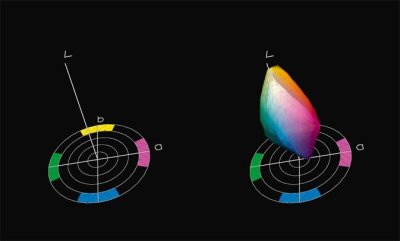articles/Digital/colouradjust6-page1
Colour Adjustment - Part 6 - part 1 of 1 2 3
by Mike McNamee Published 01/09/2003
Tucked away in the top right corner of the colour picker in Photoshop are some radio buttons marked L, a, and b. These belong to a colour mode known as Lab and are often the last stopping place for a Photoshop user on their journey to expert status. However when used correctly (and often sparingly) Lab can provide some spectacular results for the power user. If you want to know more, read on.
What is Lab In an RGB Photoshop image you will find four channels, the Composite RGB, a Red, a Green and a Blue. Between them they define the actual colour and density of a pixel and they are inter-related. A neutral pixel will have RGB values that are all equal for example 121R 121G 121B is a mid tone 18% grey (in a system with a gamma of 2.2). If you try to remove a red cast using the Red curve by moving the curve you also change the tone density. You are continually forced to consider whether to correct the red by removing red or adding blue and green. Both will correct the colour cast but one will make the tone lighter, the other move will make the tone darker.
This is the key difference with Lab - the colour and tone density are divorced from each other and can be independently adjusted without any cross-over effects. The channels in Lab are the L-Channel, the lightness or Luminosity a-channel the greenness to redness (-128 is green +128 is red)* b-channel the yellowness to blueness (-128 is blue +128 is yellow)

The magenta-green and yellow-blue opponent colours show on the axes of the Lab £D colour space, the lightness rises on the vertical plane. The shape of a gamut is shon on the right. Only those colours which lie within this shape can be accurately printed by the device, other colours will be adjusted.
*The green is actually close to an aqua and the red is closer to a magenta. When the Lab colour was defined (also known as L*A*B* or L*a*b* or CEI Lab) they chose the colour pairs on the grounds that we do not perceive any "greenyreds" or "yellowy-blues" - they are essentially opponent colours.
Practical Importance The practical importance of Lab is that colour and detail are not linked. A colour with aand b values of zero is always neutral, regardless of how light or dark it is. Therefore if you have an image that has neutral colour balance you can steepen the L-channel and add sparkle to the result by increasing the contrast OR you can steepen both the and b channels whilst keeping their curves passing through the mid points without affecting the colour balance but increasing their saturation.
In the example landscape shown, the image is very slightly blue but overall the early morning light has not produced much colour saturation. Increasing the contrast was not appropriate as it would have veiled the highlights and clogged the shadows- the Lightness channel was therefore left untouched. More sparkle was however provide by steepening both the a and b channels by rotating the curves around the centre point of the curves graph. Note in the composite screen grab how flat looking the channels are and that the Lightness channel is a moderately good monochrome image containing all the tone density and details.
You are currently on page 1
- Colour Adjustment - Part 6 page 1
- Colour Adjustment - Part 6 page 2
- Colour Adjustment - Part 6 page 3
1st Published 01/09/2003
last update 09/12/2022 14:52:36
More Digital Articles
There are 16 days to get ready for The Society of Photographers Convention and Trade Show at The Novotel London West, Hammersmith ...
which starts on Wednesday 14th January 2026





